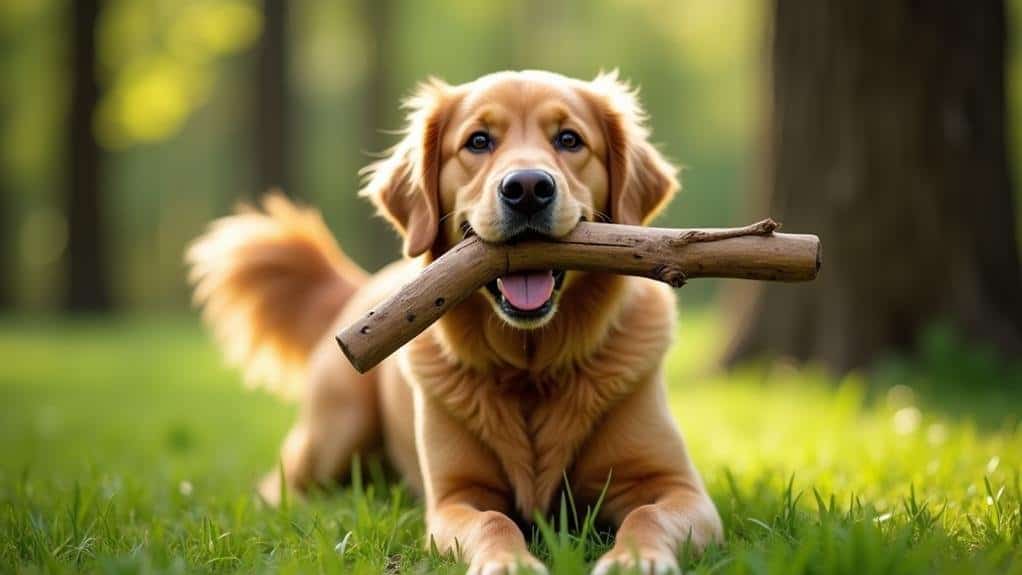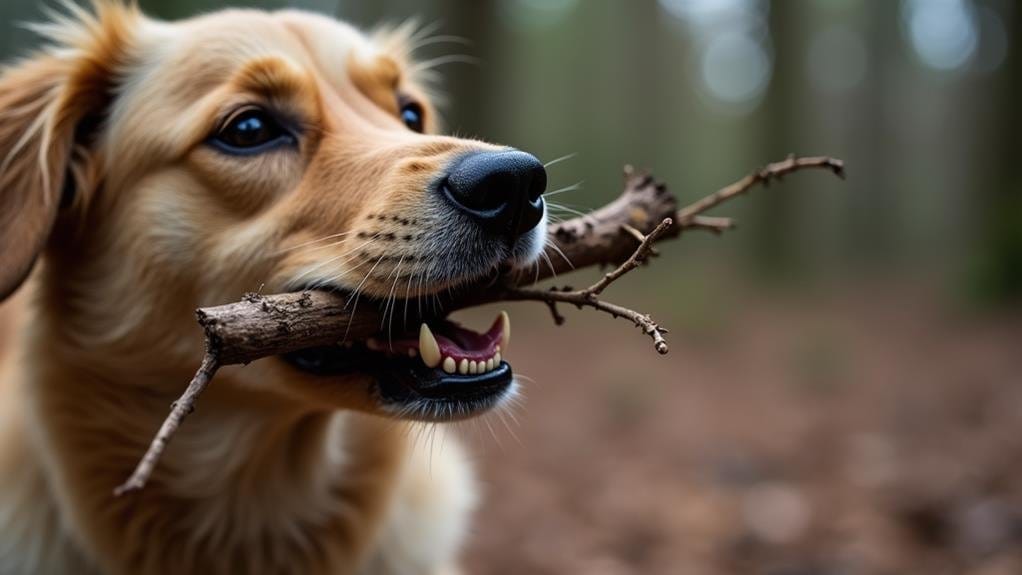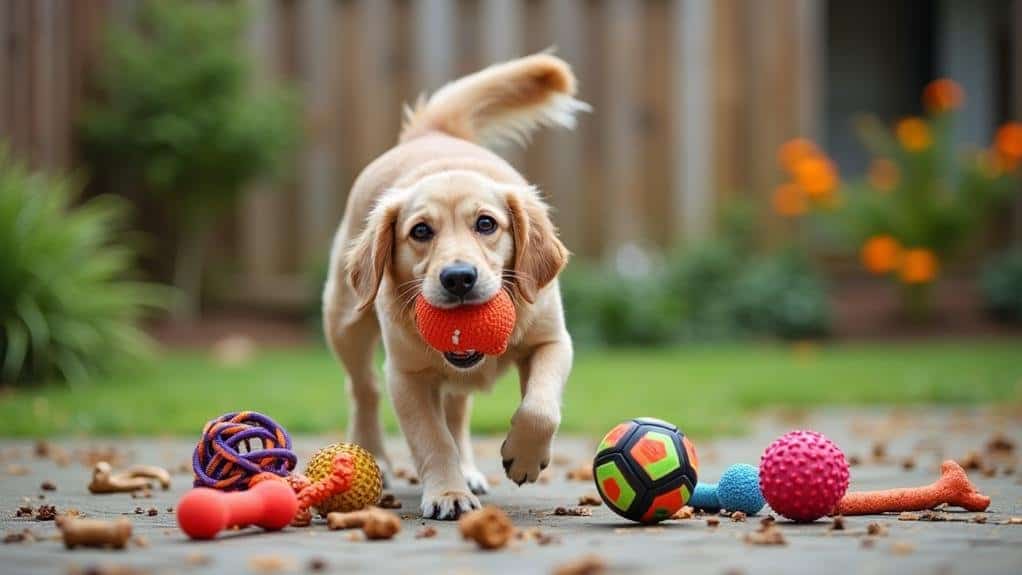Dogs chew on sticks due to their natural instincts, rooted in ancestral behaviors. This habit provides mental stimulation, physical exercise, and a rich sensory experience. While it can improve oral hygiene and alleviate stress, stick chewing also poses risks like oral injuries, gastrointestinal blockages, and choking hazards. To manage this behavior, you can offer safe alternatives like rubber toys or natural chews, and use positive reinforcement to encourage appropriate chewing. Consistency in monitoring and providing variety in chew toys is key. By understanding the appeal and risks of stick chewing, you'll be better equipped to keep your furry friend safe and satisfied.
Natural Instincts Behind Stick Chewing

The natural instinct for dogs to chew on sticks is deeply rooted in their ancestral behaviors. When you see your furry friend gnawing on a branch, you're witnessing a behavior that's been passed down through generations of canines. This natural behavior isn't just about entertainment; it's a way for dogs to explore their environment and engage their senses.
Chewing on sticks provides mental stimulation and physical exercise for your dog. It's an instinctual activity that mimics the actions of wild canines, allowing domesticated dogs to connect with their primal nature. The texture, smell, and taste of sticks offer a rich sensory experience that's highly appealing to your pet.
For some breeds, like Retrievers and Pointers, stick chewing is particularly ingrained. These dogs have been bred to carry objects in their mouths, making the act of picking up and chewing sticks an even more natural and enjoyable activity.
As your dog interacts with sticks, they're not just playing; they're satisfying deep-seated urges to explore, investigate, and engage with their surroundings in a meaningful way.
Benefits of Chewing Sticks

Despite common misconceptions, allowing your dog to chew on sticks can offer several benefits. When your furry friend engages in this activity, they're actually tapping into their natural instincts, mimicking the behavior of their wild ancestors who gnawed on bones for nutrition and dental health.
One of the primary advantages of chewing on sticks is improved oral hygiene. As your dog chews, the stick acts as a natural toothbrush, scraping off tartar and helping to keep their teeth clean. This can contribute to better overall dental health for your canine companion.
Chewing on sticks also provides mental stimulation for your dog, which can help alleviate stress or boredom. It's an engaging activity that keeps their mind occupied and can promote a calmer demeanor.
Additionally, the act of chewing and playing with sticks serves as a form of physical exercise, allowing your dog to burn off excess energy.
Lastly, stick chewing enhances your dog's exploration of their environment. It's a sensory-rich experience that allows them to interact with natural objects, satisfying their curiosity and enriching their daily lives.
Potential Dangers for Dogs

In spite of the benefits, letting your dog chew on sticks comes with significant risks. Chewing sticks can lead to serious oral health issues, as splinters may cause mouth injuries, cutting or puncturing your dog's gums and tongue.
Swallowed stick fragments pose an even greater threat, potentially resulting in severe gastrointestinal blockages that often require surgical intervention.
The risks associated with this behavior extend beyond internal injuries. Your dog faces an increased choking hazard when chewing on sticks, as broken pieces can lodge in their throat and obstruct breathing.
Additionally, contaminated wood may harbor harmful bacteria, raising the likelihood of infections.
Consider these potential dangers:
- Oral injuries from splinters and sharp edges
- Intestinal blockages from ingested wood fragments
- Choking on broken stick pieces
- Accidental impalement during play
Perhaps the most alarming risk is the possibility of accidental impalement. This can occur when dogs run while carrying large sticks, potentially leading to severe injuries.
Given these dangers, it's essential to weigh the appeal of chewing sticks against the potential harm to your dog's well-being.
Alternatives to Stick Chewing

Fortunately, you've got plenty of safe alternatives to keep your dog happily chewing without the risks of sticks. Safe alternatives like rubber toys and nylon chews provide a durable option that satisfies your dog's natural chewing instinct.
These chew toys are designed to withstand vigorous gnawing while keeping your dog engaged and preventing boredom.
Natural chew options such as antlers or horns can also be suitable, offering a safe chewing experience while you're monitoring for size and sharpness.
Remember to regularly rotate chew toys to maintain your dog's interest and reduce the urge to seek out sticks.
For dogs with anxiety-related chewing behaviors, CBD + CBDA chews can help alleviate stress and provide mental stimulation.
These treats offer a dual benefit of relaxation and a satisfying chew.
Training commands like "drop it" or "leave it" are valuable tools to redirect your dog's attention when they show interest in sticks.
By consistently using these commands, you can guide your dog towards safer chewing choices.
Ultimately, providing a variety of safe chew toys and maintaining engagement through training and rotation will help keep your dog happy and healthy without resorting to stick chewing.
Managing Your Dog's Chewing Habits

When it comes to managing your dog's chewing habits, consistency is key. To effectively manage your dog's tendency to chew sticks, you'll need to be proactive and attentive.
Regularly monitor your dog's chewing habits to identify any unsafe behaviors, such as swallowing large pieces or showing signs of distress.
Implement positive reinforcement techniques by rewarding your dog for choosing appropriate chew toys instead of sticks. This will help reinforce desired behaviors and discourage stick chewing.
Provide a variety of safe chew toys, like rubber or nylon options, to maintain your dog's interest and prevent them from resorting to sticks.
Incorporate consistent training sessions to teach commands that can help redirect your dog's attention from sticks to safer alternatives. Some effective commands include:
- "Drop it"
- "Leave it"
- "No chew"
- "Take toy"
Ensure your dog's exercise needs are met daily to reduce boredom, which can lead to destructive chewing behaviors, including stick chewing.
Frequently Asked Questions
Why Does a Dog Chew on a Stick?
Your dog chews on sticks because it's a natural instinct. It satisfies their urge to gnaw, helps clean their teeth, and provides mental stimulation. Plus, sticks are readily available outdoors and great for fetching games.
Is It Harmful for Dogs to Eat Sticks?
Yes, it's harmful for dogs to eat sticks. You'll want to prevent this habit as it can cause mouth injuries, intestinal blockages, and infections. It's also a sign of potential health issues that you should address with your vet.
How Do I Get My Dog to Stop Chewing and Eating Sticks?
To stop your dog from chewing sticks, supervise them closely outdoors. Offer safe chew toys as alternatives. Use positive reinforcement when they choose appropriate items. Provide regular exercise and teach commands like "leave it" to discourage stick chewing.
Why Do Dogs Chew on Things They Aren't Supposed To?
Your dog chews on inappropriate items due to instinct, boredom, or anxiety. They're exploring their world, seeking stimulation, or coping with stress. Some breeds are more prone to this behavior. Positive reinforcement can help redirect their chewing habits.
Conclusion
You've learned why your dog chews sticks and the risks involved. While it's a natural behavior, it's important to monitor your pup closely. Consider safer alternatives like chew toys or dental treats. If you can't break the habit, choose smooth, clean sticks and supervise playtime. Remember, your dog's health comes first. By understanding and managing this behavior, you'll guarantee your furry friend stays safe while still enjoying their natural instincts.

